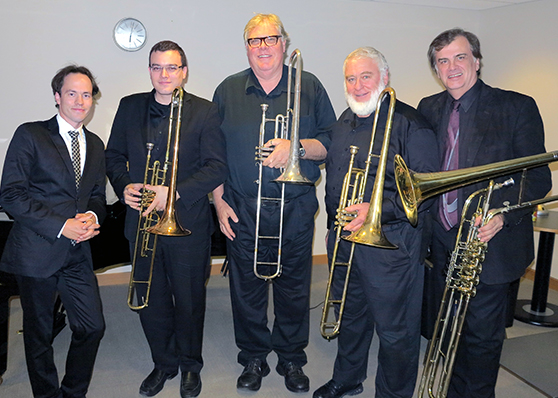-
Can we get a womp-womp for valve trombones?
By Meighan SzigetiPosted in Falstaffby Meighan Szigeti, Associate Manager, Digital Marketing
With Falstaff wrapping up its wonderful run at the Four Seasons Centre, we thought we'd ask the members of the low brass section of the COC Orchestra - Charles Benaroya (Principal trombone), Ian Cowie (trombone), Herbert Poole (trombone), and Scott Irvine (tuba/cimbasso) - a bit about what's helping bring Verdi's very human, and humorous opera to life: the valve trombone!

(l-r: Johannes Debus, Musical Director; Charles Benaroya, Principal trombone; Ian Cowie, trombone;
Herbert Poole, bass trombone; and Scott Irvine, tuba/cimbasso.)
----------------------------
You might call Giuseppe Verdi obsessive when it came to the slightest detail, but it’s those small changes that truly bring out the mood that the composer was trying to achieve.
That’s where the valve trombone comes in.
Verdi envisioned a low brass section that could articulate the very quick, light passages that communicate not only the humor but also the very rich, human tone in the score. Falstaff was also Verdi’s last opera, and with decades of experience behind him, he went "all out" and a score that used all of the instruments to their fullest effect.
Charles Benaroya, Principal trombonist in the orchestra explains that when Verdi “was really starting to orchestrate at his best, he had these specific instruments in mind in his last two operas especially [Otello and Falstaff]. Everything gets used really well, in lots of different ways and there are a lot of fun effects [in Falstaff’s score].”
Verdi may have very well be pleased with the COC Orchestra, as the COC is only one of two opera companies that recently used these unique instruments in their repertoire! In fact, for most Italian operas the COC low brass will use older instruments to fully realize the composer’s intended ideas in the score.
But why go that extra mile? Benaroya explains that “Slide trombones today that are used in symphonies have been trending towards becoming bigger which leads to a broader heavier sounds, which is great if you’re announcing the arrival of the Valkyries, or if Salome is dying, but in this music, which is lighter and more humourous, the lighter, crisper sound that you get from the Valve trombones contributes to a more appropriate mood.”
What's the difference anyway?
Charles explains what the difference is (and watch below to really hear it!) and why they might have fallen out of fashion: “On a Slide trombone, I had to articulate [with different breaths], or else you would end with one big 'smear' but on the Valve trombone you can do one stream of air, and the valves do all the work.”
“Certain things are easier on a Valve system instead of a slide system, but as the instruments fell out of fashion, and then people stopped writing for them, because they knew they would be played by slide trombone players. The valve trombone never came into common use outside of Italy because the straighter tubing in a slide trombone allows for better airflow through the instrument, leading to a bigger, purer sound."
It might not seem like much of a difference to the average listener, but here's a an excerpt of a passage from Verdi’s Falstaff to illustrate how this instrument is bringing the score to life:
FUN FACT: Did you know the instrument being used by Charles (far left in the video clip) was owned by none other than Rob McConnell, founder and Director of the Boss Brass? This renowned group of Toronto-based brass musicians recorded many albums, including recording with famous singers like Mel Tormé!
